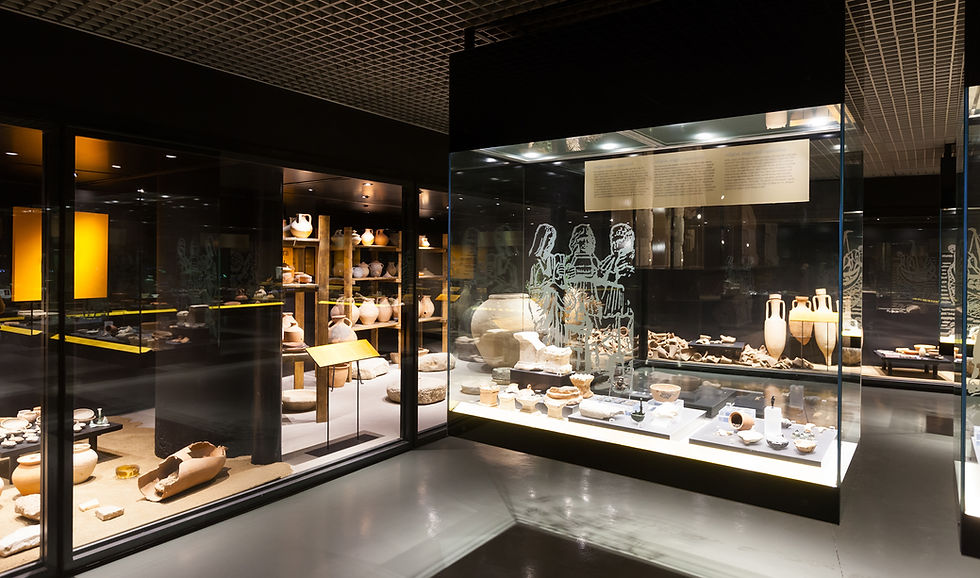AHRC funding of £800,000 for the Museum Data Service
- Heather Fearfield
- Aug 16
- 4 min read
Updated: Aug 17

The Museum Data Service (MDS), a project to create a centralised catalogue of object records across UK museums, has received £800,000 from the UKRI Arts and Humanities Research Council (AHRC). MDS is a joint venture between the University of Leicester and its partners Art UK and Collections Trust, reports the Museums Association.
The three-year funding from the AHRC, it says, will allow the partners to continue developing the digital infrastructure needed to help the project reach its ultimate aim to collect data for 100 million object records. MDS currently has data for over six million objects drawn from over 150 accredited museums.
MDS chair Catherine Eagleton said: “We are so grateful to AHRC for this funding, supporting our bold and ambitious goal for the Museum Data Service to bring together catalogue data from all of the UK’s museums, large and small.
“Since its launch in September 2024, MDS has already doubled the number of records available to six million and this support means we can continue to develop and grow, working closely with the other parts of the AHRC’s digital research infrastructure to revolutionise access to and research with collections.”
Separately in March, Professor Murray Pittock, at the University of Glasgow, spoke at Future Cities Forum on its research project into the value of digital museum collections online. He stated it was important to create a sustainable and commercial model for the virtual museum:
'Our survey showed that those who took part were very enthusiastic about the idea of virtual museums, they want more curatorial detail around objects but they also want to visit on site.'
The £5.6m Museums in the Metaverse (MiM) project at the University of Glasgow surveyed more than 2,000 people worldwide, and found 79% of respondents expressed interest in using digital technology to explore collections currently unavailable to the public.
Funded by UK Research and Innovation, MiM is developing an XR platform to showcase cultural heritage collections. With an estimated 90% of collections held in storage globally, digitising archives is seen as a way to broaden public engagement and increase accessibility.
The University of Glasgow commented:
'The survey also revealed high levels of awareness regarding VR technology, with 96% of respondents being familiar with it and 55% have engaged with it in some form. VR provides a fully immersive digital experience, often accessed through headsets, while XR is an umbrella term that encompasses all immersive technologies.'
Professor Pittock, who is Pro-Vice Principal of Special Projects at the University of Glasgow and co-author of the report, said:
“Our research reveals a clear appetite for immersive digital experiences, with people eager to interact with cultural artefacts in new and exciting ways. This shift in public expectations is already visible in the growing popularity of virtual reality cultural spaces globally, and our findings at Glasgow are helping chart a course for how museums can embrace this digital future.”
Under the MiM project, the University of Glasgow unveiled a VR exhibition celebrating the pioneering scientist Lord Kelvin. The exhibition features objects not normally on public display, presented within a digitally recreated, historically accurate 19th-century laboratory.
It states:
'The study also highlighted the potential of XR technology to attract younger audiences, with previous virtual projects having engaged large numbers of 25 to 34-year-olds.'
In 2023, the Musée d’Orsay in Paris launched its immersive VR experience, 'Tonight with the Impressionists, Paris 1874,' to record success, drawing 18,000 visitors in just five months. Using VR headsets, audiences engaged with artists and their famous works, including Claude Monet and Edgar Degas.
MiM is due to be completed in March 2025, and will launch an innovative two-sided XR platform. One side will allow visitors to explore cultural assets through immersive experiences, while the other will enable curators – both experts and novices – to craft new narratives by combining objects and virtual environments in ways not possible in the physical world.
Professor Murray told Future Cities Forum:
'There is an appetite to have virtual museums with a high level of virtual realism. People want to get inside walrus skulls or on the same level with giant beetles for instance. Museum objects can be difficult to see on site. The Paris 'Meet the Impressionists' had an add-on of 16 Euros to the normal museum entry fee and the high numbers of visitors meant that one million Euros was collected. It almost covered the museum's costs. It is now going on tour and the (profit) margin will become much more rewarding.
'I would advise museums to create a consortium and buy in the experience of commercial suppliers. Seeing a virtual city presented in the past or present day can move intention to visit by tourists by up to forty per cent. Museums should liberate what is in their stores and be conscious of creative quarters and districts as a wayfinding experience which can be done virtually. This has a better payback than someone standing in front of a camera encouraging people to visit Bognor.'
'If a museum display is in keeping with the current virtual connection, it really can extend the impetus. Vienna's exhibition 'Last Days of Pompei' proves this. Cities like Paris and Vienna which have a higher percentage of cultural visitors, also have the highest demand for virtual experience.
'When the V&A Museums Ocean Liners exhibition went to Dundee, the number of visitors dropped and at the same time the prices were not reduced. Whereas the virtual museum can enable people to lift objects and explore them from their home. The virtual museum and its objects are of course perpetually present and people's visits to it can be recuring unlike the physical exhibition that eventually ends. It can have a strong level of curation. From it, people can go on to create their own exhibitions.'
Below: poster courtesy of V&A for 'Ocean Liners - Speed and Style' at V&A Dundee




Comments